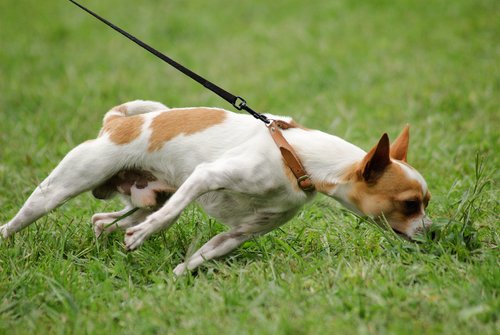Leash Training: When Your Dog Refuses to Walk


Written and verified by the biotechnologist Alejandro Rodríguez
You take your dog out for a walk, and all of a sudden he stops and refuses to walk any further. Has this ever happened to you? Well, let’s learn about leash training, a technique that can help you enjoy walking with your canine friend. Firstly, let’s see some reasons why your dog may stop dead in the middle of a walk.
Why doesn’t my dog want to walk?
It can be a frustrating situation when your dog refuses to walk. It’s common for you to start pulling on the leash to try to get your dog to move, and you might start to get a little frustrated. It’s true that there are many reasons that can make your dog stop when you’re taking it for a walk.
Among the most frequent causes are:
- Your dog is stressed or scared
- It hasn’t learned to walk correctly
- It’s easily distracted by the surroundings
- The canine may be suffering from some type of pain that impedes walking
- Your dog may either be a puppy or an older dog
Identifying which of the above reasons may be causing your dog to refuse to walk isn’t always easy. In a similar vein, the solution to some of these problems may need a qualified animal expert.

What is leash training?
On many occasions, the problem may be related to how your dog views the leash. How can you get your dog to accept the leash and to think of it as an extension of your arm? You’ll need to familiarize your dog with the leash before starting out on a walk.
Leash training consists of carrying out different activities with the goal of building your dog’s confidence in the leash. The first step starts at home: let your dog discover the leash and smell it. Then, to reinforce good behavior, you can hide the leash and reward your dog when it finds it again.
Above all else, it’s important not to lose patience with your dog. Once you’ve taken these first steps, you can start to put the leash on your dog, gradually, and reward good behavior if necessary.
If you’ve got to this point, but your dog still refuses to walk when you take it out, you may have to apply the above steps for leash training during the actual walk. Make sure you don’t yell at your dog or pull on the leash. Be patient and keep walking on your own. If your dog comes after you, use positive reinforcement and reward it with a treat.

Many cases of dogs that refuse to walk on the leash have to do with insufficient education and training. In these cases, if you take another well-trained ‘guide dog’ with you on the walk, then this could give excellent results with your dog.
And what if my dog is scared or sick?
In these situations, the best thing to do would be to take your dog to see an ethologist. This expert on animal behavior can guide you and help your canine friend to overcome fears that may be paralyzing it.
If, on the other hand, you’ve noted that your dog is in pain when walking, or is an older dog, then you should take it to see a trusted vet more frequently. It’s your responsibility to do everything in your power to make sure your dog is as healthy and happy as possible.
You take your dog out for a walk, and all of a sudden he stops and refuses to walk any further. Has this ever happened to you? Well, let’s learn about leash training, a technique that can help you enjoy walking with your canine friend. Firstly, let’s see some reasons why your dog may stop dead in the middle of a walk.
Why doesn’t my dog want to walk?
It can be a frustrating situation when your dog refuses to walk. It’s common for you to start pulling on the leash to try to get your dog to move, and you might start to get a little frustrated. It’s true that there are many reasons that can make your dog stop when you’re taking it for a walk.
Among the most frequent causes are:
- Your dog is stressed or scared
- It hasn’t learned to walk correctly
- It’s easily distracted by the surroundings
- The canine may be suffering from some type of pain that impedes walking
- Your dog may either be a puppy or an older dog
Identifying which of the above reasons may be causing your dog to refuse to walk isn’t always easy. In a similar vein, the solution to some of these problems may need a qualified animal expert.

What is leash training?
On many occasions, the problem may be related to how your dog views the leash. How can you get your dog to accept the leash and to think of it as an extension of your arm? You’ll need to familiarize your dog with the leash before starting out on a walk.
Leash training consists of carrying out different activities with the goal of building your dog’s confidence in the leash. The first step starts at home: let your dog discover the leash and smell it. Then, to reinforce good behavior, you can hide the leash and reward your dog when it finds it again.
Above all else, it’s important not to lose patience with your dog. Once you’ve taken these first steps, you can start to put the leash on your dog, gradually, and reward good behavior if necessary.
If you’ve got to this point, but your dog still refuses to walk when you take it out, you may have to apply the above steps for leash training during the actual walk. Make sure you don’t yell at your dog or pull on the leash. Be patient and keep walking on your own. If your dog comes after you, use positive reinforcement and reward it with a treat.

Many cases of dogs that refuse to walk on the leash have to do with insufficient education and training. In these cases, if you take another well-trained ‘guide dog’ with you on the walk, then this could give excellent results with your dog.
And what if my dog is scared or sick?
In these situations, the best thing to do would be to take your dog to see an ethologist. This expert on animal behavior can guide you and help your canine friend to overcome fears that may be paralyzing it.
If, on the other hand, you’ve noted that your dog is in pain when walking, or is an older dog, then you should take it to see a trusted vet more frequently. It’s your responsibility to do everything in your power to make sure your dog is as healthy and happy as possible.
All cited sources were thoroughly reviewed by our team to ensure their quality, reliability, currency, and validity. The bibliography of this article was considered reliable and of academic or scientific accuracy.
- LEVINE, Bernard I. Dog leash training device. U.S. Patent No 6,612,264, 2 Sept. 2003.
- García, C. A. L. (2004). Adiestramiento canino cognitivo-emocional. Ediciones Díaz de Santos.
- Trigosso, R. (2007). Manual de Adiestramiento canino: Obediencia básica. recuperado el 7 de septiembre de 2022, disponible en: https://d1wqtxts1xzle7.cloudfront.net/34639663/Manual-de-Adiestramiento-Canino-with-cover-page-v2.pdf?Expires=1662514231&Signature=YYigVAfM86ARR4ZgZ-YptqgqO-PJaVn1E5qnZ3XppW2h96lqHM9HKAm5Fu6myYstWUvO~tiCQbsTwNRPvJGNeO7NBsbkOZS2TyIaEPz17WPbFdWpF22lZHyWrMzVQvkuBuXk927xnLANCykAkywy0Z1xmAxVMWf-RP1kMHLApUbdnvrnlCxWyV4lFfs9kNpqTlipY-AxjFjZdsYlTk11-lpxGBXl~TuVbx4n6TTNQTU7ePRXROPCLNUX-SqiJtrOzxwUOJjv2eGXw7OmYDgFu8gwwwXSzbsCRsEBXeazzwGN3MGtqIiy1O3mi0jwshAg5z6maX~4W6hzIiOQx5ikFQ__&Key-Pair-Id=APKAJLOHF5GGSLRBV4ZA
This text is provided for informational purposes only and does not replace consultation with a professional. If in doubt, consult your specialist.








